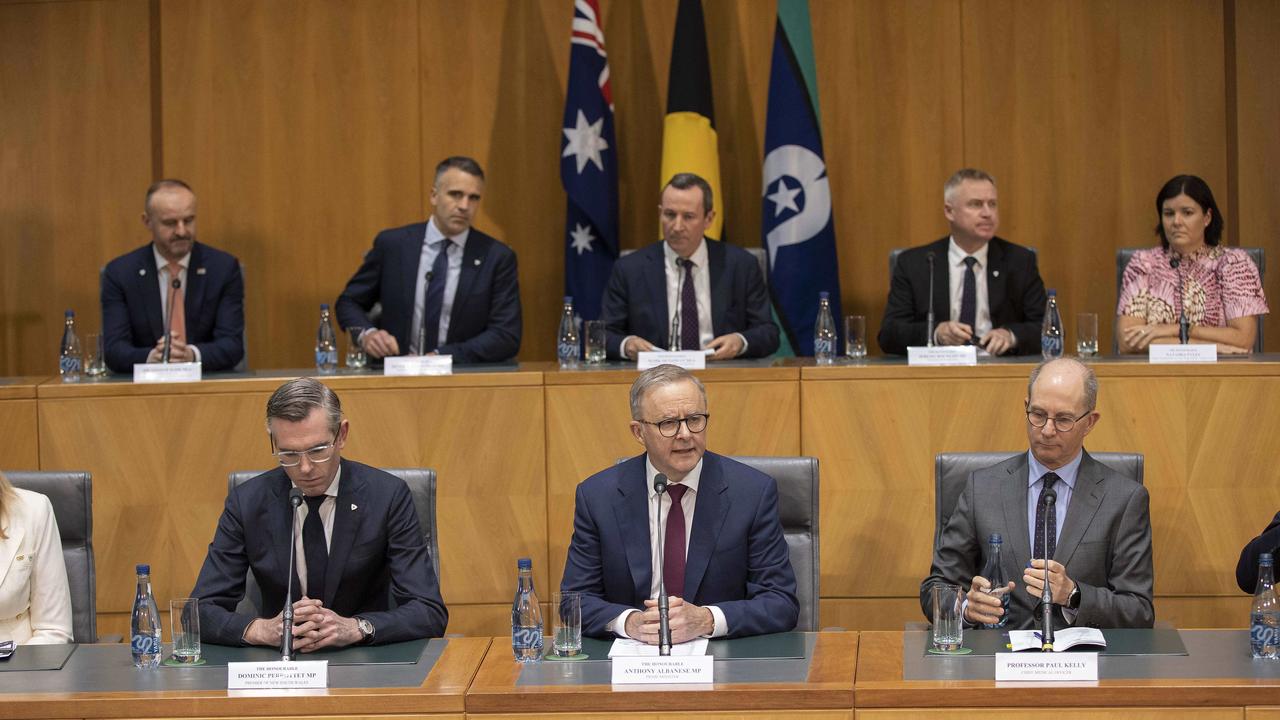Health officer offers cryptic tweet after ditching of mandatory isolation
There are suspicions Victoria’s chief medical officer Brett Sutton had plenty more to say following the country’s ditching of mandatory isolation.
Victorian chief medical officer Brett Sutton has warned that “sleepwalking” into the next phase of the Covid pandemic is risky in a cryptic social media post that hinted he has reservations over dumping mandatory isolation.
Professor Sutton and other state chief medical officers were cut out of the decision making process to scrap the current iso rules.
Instead, the Prime Minister sought advice from the federal chief medical officer Professor Paul Kelly alone.
The changes were then endorsed by state premiers in a unanimous decision of the national cabinet.
This morning, ahead of today’s national cabinet, Professor Sutton warned in a social media post that the pandemic was not over.
“Sleepwalking into Covid is not a strategy I would recommend. Still much remains uncertain,’’ he wrote.
Professor Sutton then linked to an article headlined “Big COVID-19 waves may be coming, new Omicron strains suggest”.
Sleepwalking into COVID is not a strategy I would recommend. Still much remains uncertain. https://t.co/vtEQ1V2HoG
— Chief Health Officer, Victoria (@VictorianCHO) September 29, 2022
The article, in Science, warned that several new and highly immune-evasive strains of the virus have caught scientists’ attention in recent weeks and that “one or more may well cause big, new COVID-19 waves this fall and winter.”
“We can say with certainty that something is coming. Probably multiple things are coming,” said Cornelius Roemer, who studies viral evolution at the University of Basel. Whether they will also lead to many hospitalisation and deaths is the big question.”
The chief medical officer Paul Kelly’s letter of advice was publicly released today by the Prime Minister’s office.
“I understand from our conversation earlier today that you are seeking medical advice with regard to the proposal to remove mandated isolation for those who test positive for COVID-19,’’ Professor Kelly wrote.

“It is my long-held view that public health measures need to be based on available evidence, proportionate and equitable. The agreed policy intent of the Australian response to the COVID-19 pandemic has moved away from the elimination of community transmission to protecting the most vulnerable from severe disease and death.
“In the current Australian context of low community transmission and high hybrid immunity from vaccination and recent infection, it is my view that removing mandated isolation requirements in the current period would not materially detract from Australia’s pandemic response and would be consistent with the current aims of that response.”
However, Professor Kelly said this did not mean that the pandemic was “over” as some have suggested.
“I stress that this does not in any way diminish the importance of strongly encouraging those with respiratory illness, and particularly people with confirmed Covid, to stay at home and particularly to avoid high risk settings while they are symptomatic and therefore likely to be at the peak of infectiousness,’’ he said.
AMA President @DrSteveRobson tells @BreakfastNews that scrapping mandatory COVID isolation would have dangerous health consequences. #auspolpic.twitter.com/bdXub10ivn
— Michael Rowland (@mjrowland68) September 29, 2022
“However, isolation periods should not be considered independently of other important factors because the epidemiological situation in Australia can change quickly, as we saw with the emergence of the Omicron variant in the summer of 2021-22.
“I therefore suggest that you task the appropriate body to come back to national cabinet with a detailed transition plan which would adequately prepare Australia to respond to a surge in cases likely to impact the health system and/or a new variant of concern with greater severity in the future.”
Professor Kelly said Australia was experiencing a rapid and substantial decrease in cases, hospitalisations and ICU admissions, and the number and size of Residential Aged Care outbreaks since the peak of the most recent BA. 5 wave at the end of July 2022.
“Recognising that testing and therefore case ascertainment is likely lower than previously, we are in a better epidemiological situation than at any time since December 2021 for most measures, and April 2022 for hospitalisations,’’ Professor Kelly said.
“While we are closely monitoring new sub-variants of the Omicron variant which continue to emerge, at this stage the situation in Australia is stable.”

Australians were also highly vaccinated with two doses and a high proportion of those who are most vulnerable to severe infection having received at least one booster dose.
Studies have shown that almost half of Australian adults and almost two thirds of young adults had been infected at least once by June 2022, with further increases during the most recent wave.
“It is likely that an even higher number of children have been infected at least once,’’ he said.
“This hybrid immunity will continue to provide protection against severe disease and will, at least in the short term, modify transmission in the community.
“In contrast to earlier stages in the pandemic response, Australia now has a number of readily accessed pharmaceutical measures (vaccines and treatments), rapid diagnostic capability, adequate personal protective equipment and appropriate infection prevention and control procedures to protect those at higher risk of severe COVID-19 and to limit outbreaks in high-risk settings.

However, Professor Kelly said it was highly likely that further waves of infection will continue to occur over the next two years at least.
“This is due to a combination of viral factors (continued genetic variation resulting in immune escape, higher transmissibility, and possibly higher severity), human biology (waning immunity from infection and vaccination), human behaviour (lower adherence to public health messaging including mask wearing, testing, staying home when sick and vaccine fatigue), and environmental factors (winter seasons and removal of remnant public health and social measures (PHSM) and test, trace, isolate and quarantine (TTIQ) measures),’’ he said.
“We may even see the emergence of a very different variant before the end of 2022.
“On the basis of these current epidemiological and pandemic control settings, in the context of high underlying immunity within the population, as well as readily available pharmaceutical interventions, I consider that a change in mandated isolation periods at this time is a reasonable approach. Constant vigilance and a strong commitment as well as continued capacity to surge the response if required will remain important in the next phase of Australia’s COVID-19 pandemic response transition.”






